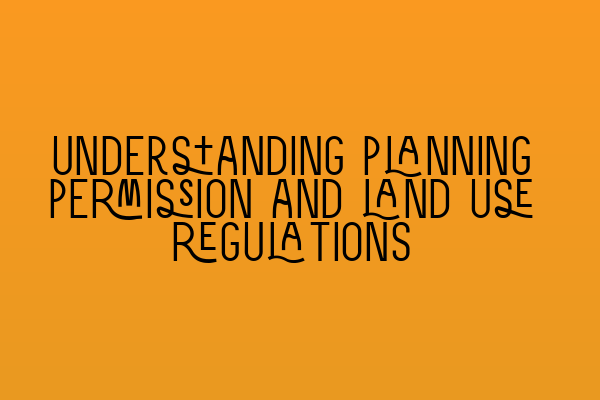Understanding Planning Permission and Land Use Regulations
When it comes to property development and construction, one of the most important aspects to consider is planning permission and land use regulations. Obtaining the necessary permissions and complying with regulations is vital to ensure the legality and feasibility of any project. In this article, we will delve into the world of planning permission and land use regulations, providing a comprehensive guide to help you navigate through the process successfully.
What is Planning Permission?
Planning permission is formal consent from the local planning authority to carry out a proposed development or change the use of land or buildings. It ensures that any development aligns with the local development plan and enforces certain conditions to protect the surrounding environment and community.
Before commencing any development, it is essential to understand whether planning permission is required. Some developments may be permitted without the need for formal consent, while others may require various levels of planning permission depending on the nature and scale of the project.
Types of Planning Permission
There are several types of planning permission that you may come across:
- Outline Planning Permission: This type of permission establishes whether a proposed development is acceptable in principle. It does not provide detailed information about the project but gives an indication of its feasibility.
- Full Planning Permission: Full planning permission grants consent for a specific development, specifying the size, design, and use of the proposed development.
- Reserved Matters: Reserved matters applications follow an outline planning permission and provide details on specific aspects of the development that were not included in the original outline.
- Listed Building Consent: In cases where a building is listed as of historical or architectural importance, listed building consent is required for any proposed alterations or renovations.
Understanding Land Use Regulations
Land use regulations are legal provisions that control how land and property can be used within a specific jurisdiction. These regulations vary depending on the local planning authority and can significantly impact property development and usage.
Some common land use regulations you may encounter include:
- Zoning: Zoning divides land into specific areas with designated uses, such as residential, commercial, industrial, or agricultural. Zoning regulations control the types of structures and activities allowed within each zone.
- Setback Requirements: Setback requirements determine the distance a building must be set back from the property line or road. They ensure proper spacing, aesthetics, and safety.
- Height Restrictions: Height restrictions limit the maximum height of structures allowed within a particular area to maintain the character and skyline of a region.
- Environmental Regulations: Environmental regulations focus on protecting natural resources, wildlife habitats, and the overall environment. They dictate how developers must mitigate the impact of their projects on the surrounding ecosystem.
- Historical Preservation: Historical preservation regulations aim to protect historically significant buildings and structures from demolition or alterations that may compromise their cultural value.
Importance of Compliance
Complying with planning permission and land use regulations is of utmost importance for numerous reasons:
- Legal Compliance: Failure to comply with planning permission and land use regulations can result in legal consequences, including fines, injunctions, and even demolition of unauthorized structures.
- Community Harmony: Complying with land use regulations ensures that developments do not negatively impact the surrounding community or disrupt the overall harmony of an area.
- Environmental Responsibility: Strict compliance with environmental regulations helps protect natural resources, wildlife, and ecosystems.
- Property Value: Illegal or non-compliant developments can have a negative impact on property values, making it crucial to comply with regulations to maintain the value of investments.
The Application Process
The process of obtaining planning permission and ensuring compliance with land use regulations typically involves the following steps:
- Pre-Application Consultation: It is advisable to engage in pre-application consultations with the local planning authority to receive guidance on the planning process and regulations specific to the area.
- Submission of Application: Submit a detailed planning application, including relevant plans, drawings, and supporting documents outlining the proposed development.
- Application Review: The local planning authority will review the application, considering factors such as impact, design, access, and compliance with regulations.
- Public Consultation: Depending on the scale and impact of the proposed development, a public consultation may be required, allowing interested parties to provide feedback and express their concerns.
- Decision: The local planning authority will either grant or refuse planning permission, usually stating any conditions that must be met for approval.
- Implementation: Once planning permission is granted, the development can proceed, ensuring full compliance with the specified conditions.
It is important to note that the application process and regulations can vary between jurisdictions. Therefore, it is essential to consult with professional solicitors specializing in property law and land use regulations to navigate the process effectively.
Conclusion
Understanding planning permission and land use regulations is vital for anyone involved in property development or construction. By ensuring compliance with the legal and regulatory framework, developers can avoid legal consequences, maintain community harmony, protect the environment, and preserve property values. Navigating the often complex application process requires professional guidance and expertise, making it crucial to consult with experienced solicitors knowledgeable in property law and land use regulations.
For additional resources and preparation materials for the SQE exams, check out our related articles:
